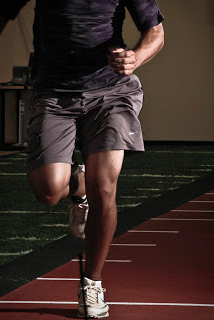
It’s so commonplace for baseball pitchers to go on their “flush run” the day after they throw, believing this slow continuous activity, usually a long jog, will alleviate soreness. Another example is intermittent sports like hockey, soccer, and rugby that perform this sustained exercise in a mythical attempt to recover from their games. The best this activity can offer is a slower athletic performance and a greater injury risk.
In order to efficiently perform an exercise for a long period of time, the body must use a shorter and stiffer range of motion. It is why you see a marathon runner using a shorter cycle than the longer stride of a 100 meter sprinter. Yet, this smaller range of motion does nothing to stretch the tight muscles from the preceding game or match. In fact, such shortened movements serve to further impede recovery, specifically through tightening the fascia. Fascia is a thin layer of soft tissue that provides support and protection for muscle, serving as a web that creates the framework for the entire body. Irritation of this fascia causes inflammation, which causes pain and even greater muscle tension.
As mentioned previously, the most widely used AND effective fascial treatment is to release your IT band, the muscle running down the side of your leg. A cheaper, longer lasting solution to a foam roller, is a thick PVC pipe. Ten repetitions down each leg for this muscle, and others such as the calf, will go a long way to relieving soreness and tightness. Of course the easiest solution to help your fascia is to limit the amount this tissue is irritated outside of your sport.
An equally important reason to avoid flush runs is the stimulus of this sustained exercise to your slow twitch fibers. Your body responds to the nature of the challenge; explosive movements recruit fast twitch muscles and slow movements activate the lower force muscles known as slow twitch fibers. Think of your body’s muscles like a pie chart with a certain composition of fast and slow twitch muscles. Every movement you do will target one of these categories more than the other, so choosing the correct recovery exercise is crucial to ensure fast twitch muscle improvement.
While we don’t want to be performing too demanding workouts to recover after games, there is a happy medium that allows a full range of motion to alleviate fascia tightness and still stimulate fast twitch muscles. Just grab a barbell and go through a normal resistance training workout, such as squats and overhead presses, but with less weight.
An old baseball coach once remarked to me, “that sitting on the couch was probably better than jogging for his players’ speed and pitching velocity.” Maybe he’s right.